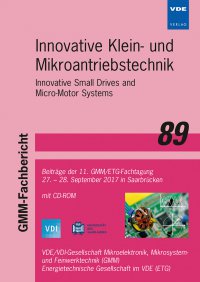Model Predictive Position Control for Permanent Magnet Synchronous Linear Motors
Conference: Innovative Klein- und Mikroantriebstechnik - 11. GMM/ETG-Fachtagung
09/27/2017 - 09/28/2017 at Saarbrücken, Deutschland
Proceedings: Innovative Klein- und Mikroantriebstechnik
Pages: 6Language: englishTyp: PDF
Personal VDE Members are entitled to a 10% discount on this title
Authors:
Wendel, Sebastian; Armin Dietz (Technische Hochschule Nürnberg, Institut ELSYS, Nuremberg, Germany)
Ralph Kennel (Technical University of Munich, Institute for Electrical Drive Systems and Power Electronics, Munich, Germany)
Abstract:
This paper presents the application oriented evaluation of a continuous control set model predictive control (CCS-MPC) approach for permanent magnet synchronous linear motors (PMSLM). MPC is one of the most promising control methods for complex and non-linear drive systems. This control method opens up new possibilities in terms of dynamics as well as reduced position and speed overshoots for electrical linear drive systems. MPC is based on the calculation of the differential equations of the controlled system several steps into the future. A cost function minimises the optimisation criteria in dependence of the model calculations and outputs the most suitable control signal for the next control cycle combined with a minimum reaction time. The cost function can consider different criteria as long as the correlation is mathematically describable. The criteria can be weighted regarding to the control target (e.g. dynamic). The evaluated CCS approach has a linear growth in calculation effort depending on the prediction horizon instead of an exponential growth in finite control set model predictive control (FCS-MPC). This leads to a manageable impact on the computational effort compared to conventional control algorithms. With the holistic view of model-based predictive control on the controlled system, it is possible to improve the position stability and dynamics of linear drives compared to state of the art control schemes such as field oriented control (FOC). Simulation and experimental results will be used to demonstrate the potential of this new control method using the example of a permanent magnet synchronous linear motor.


